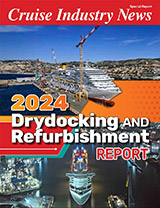“The big thing for us is two Signature-class ships in Alaska this summer,” said Dirk van der Raadt, senior manager deployment and itinerary planning at Holland America Line, in an interview with Cruise Industry News.
Alaska is continuing to be a strong market for the cruise line, which will have seven vessels (up one) in the area this summer. The Eurodam had previously been in the Mediterranean.
“Alaska is not a saturated market, even with ships coming in,” noted van der Raadt. To accommodate an influx of ships, he is planning smarter. The Eurodam will sail from Seattle while the Nieuw Amsterdam will use Vancouver as a homeport. Glacier Bay may be the most challenging area as traffic is restricted.
In Europe, the 2016-built Koningsdam will sail from Amsterdam, while the Westerdam will highlight the line’s Mediterranean program using Civitavecchia, Venice and Barcelona as turn ports.
Like most other cruise lines, Turkey is off the list and Eastern Mediterranean deployment has wound down.
“On top of the perceived security issue, the yields went down in the Eastern Mediterranean,” van der Raadt said.
Situations do change, however, as the Mexican Riviera fell apart with security issues and is now on the comeback.
“We are slowly reintroducing Mexico. There is a huge drive-up market in San Diego and a lot of people there want to cruise,” van der Raadt added.
With a fleet of 14 ships, itinerary planning still comes down to making careful choices about where the vessels go.
“That is where you make the most yield but can also be the most creative,” van der Raadt said.
“One thing that sets us apart in the Caribbean is our private island, Half Moon Cay,” he said. “We also differentiate with longer itineraries visiting the Southern Caribbean.
“Our biggest challenge is definitely port congestion,” van der Raadt continued. “Even Cozumel and Grand Cayman can get too full. We look at other destinations. We have the addition of Amber Cove recently, that’s a big one for us, giving us more flexibility.”
Ports interested in adding cruise calls or attracting any cruise calls should not be afraid to ask questions, van der Raadt advised.
“We look at a few things, starting with the geographic location of the port,” he explained. “The position is most important, and then we look at the operational situation before we look at the cost. Anchoring and tendering does not necessarily work against you if it is a nice location. We look at shore excursions, in terms of what there is to do around the facility.”
Case in point, Takamatsu in Japan, was added as a new port.
“We can dock right downtown, where as in most Japanese ports you end up at a clean cargo area.”
Excerpt from Cruise Industry News Quarterly Magazine: Spring 2017



